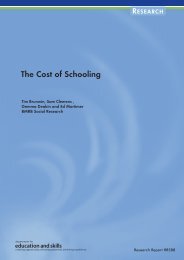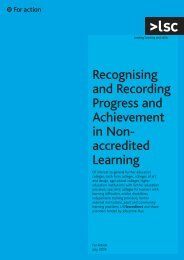Faiths and further education - Church of England
Faiths and further education - Church of England
Faiths and further education - Church of England
- No tags were found...
You also want an ePaper? Increase the reach of your titles
YUMPU automatically turns print PDFs into web optimized ePapers that Google loves.
<strong>Faiths</strong> <strong>and</strong> Further Education:A H<strong>and</strong>bookAnnex H:Valuing Chaplaincy:A Principal’s ViewMarion PlantMarion Plant is Principal <strong>of</strong> North Warwickshire <strong>and</strong> HinckleyCollege, a large college in the Midl<strong>and</strong>s that had one <strong>of</strong> the firstfull-time chaplaincies in the FE sector.The Reverend NaomiNixon is in her second year as chaplain to this richly diversecommunity.Why a Chaplaincy?Everything in FE is now more than ever quantified <strong>and</strong> measured –audits, inspections, LSC reviews etc. From this point <strong>of</strong> view, theprincipal has to be very clear about the value added by thechaplaincy. From a deeper perspective, it is essential, in thisinstrumental age, for the college to demonstrate to students <strong>and</strong>the wider community its commitment to non-instrumental values,to treating students as whole people, whatever their age, <strong>and</strong>recognising the importance <strong>of</strong> faith in students’ lives.This was from the beginning an ecumenical initiative, but wasdesigned, developed <strong>and</strong> funded from college resources.There areno external constraints – the college pays the salary, but the role ispart-funded by the chaplain being a 0.5 teacher, teaching a YouthWork course for adults wishing to work with young people.Thechaplaincy has a student <strong>and</strong> staff focus, with different activities<strong>and</strong> meetings <strong>and</strong> worship opportunities for both staff <strong>and</strong>students.There is a student liaison team at the college that meets regularly<strong>and</strong> in which the chaplain plays a full part, delivering all the usualcounselling <strong>and</strong> other services. But the chaplain contributes anadditional dimension, based on pastoral experience <strong>and</strong> trainingwhich focuses on the spiritual dimension <strong>of</strong> issues <strong>and</strong> deals withproblems as they arise.Above all, the chaplaincy is sponsored by<strong>and</strong> supported by the principal, so plays a full part in collegestructures, <strong>and</strong> all the formal parts <strong>of</strong> the college’s activities,presentations, meetings, festivals, etc.‘Holy loitering’ is the key to the informal process – the chaplain is afamiliar presence throughout the college; at the canteen/<strong>of</strong>ficeareas, in Student Services (where confidential appointments can bemade), in the worship area/prayer rooms, on both sites as well as inher <strong>of</strong>fice <strong>and</strong> in the staff room.Visibility is the key to success.Learning <strong>and</strong> success ratesThe chaplain also acts as a catalyst to learning – this reflectsevidence in Whole People Matter (Turner <strong>and</strong> Kimber, 2003) whichreminds us <strong>of</strong> the holistic nature <strong>of</strong> student learning <strong>and</strong> the needfor development <strong>of</strong> all aspects <strong>of</strong> a student’s personality, includingspiritual, ethical, social <strong>and</strong> cultural needs.Learning best takes place when all parts are being developed.Therefore, if the chaplaincy is working well, there can be increasedsuccess rates!CultureLearning communities should be optimistic places, where all feelequally valued, <strong>and</strong> feel the college is committed to them.Thismeans:• valuing students – through student services (the Student Union isalso involved in the Chaplaincy Support Group)• valuing staff (institutional core values – chaplain available to staff– including support staff); weekly communion services mainlyattended by staff• social inclusion (removing barriers to success) – multi-faithprayer room which different faiths are happy to share <strong>and</strong> use atdifferent times. Chaplain is available to help specific faith groups(such as Muslims, especially during Ramadan) <strong>and</strong> for otherfestivals – or to act as a ‘signpost’ to other faith communityleaders• chaplaincy as focal point <strong>of</strong> the community in times <strong>of</strong> crisis –sickness (staff or student); accidents; tragedies (e.g. studentdeath, community shock, external events such as the impact <strong>of</strong>the London bombings or the Asian tsunami)• helping staff connect faith <strong>and</strong> work.RetentionThere is a positive impact <strong>of</strong> chaplaincy working with excluded or‘difficult’ groups, creating links to families <strong>and</strong> faith communities,developing mentoring etc. Retention rates are steadily improving.Involvement in enrichment activities is also important.Inspection• particularly important given new criteria around the Children Act,<strong>and</strong> Ofsted’s concern with spiritual <strong>and</strong> moral welfare, collegeethos, the student as ‘whole person’• learners’ spiritual, moral, social <strong>and</strong> cultural development –this is a statutory duty for 14–16, but there is also a moral duty<strong>of</strong> care for all students (including adults, many <strong>of</strong> whom take upadult learning as a result <strong>of</strong> crisis or change in their lives, <strong>and</strong> mayneed support)
















